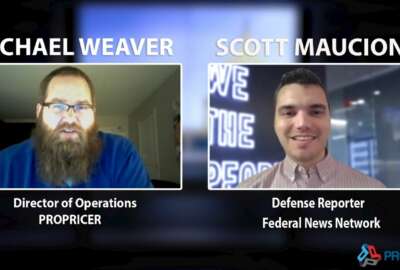
Contractors assess the Defense Department’s latest small-business strategy
Defense Secretary Lloyd Austin's department issued a new small-business strategy a couple of weeks ago. It comes as more dollars are going to fewer smaller busi...
Defense Secretary Lloyd Austin’s department issued a new small-business strategy a couple of weeks ago. It comes as more dollars are going to fewer smaller businesses. The contracting world is pondering why the small business industrial base is shrinking. For analysis of the strategy, Federal Drive with Tom Temin spoke with attorney Alan Chvotkin, a partner at Nichols Liu.
Interview transcript:
Tom Temin
What do we need to know about this new strategy from a small business standpoint?Alan Chvotkin
Well, Tom, thanks for the opportunity to talk about that. So in the end of January, when the [Department of Defense (DoD)] issue that small business policy, they recognize that small business contracting is a critical element of the success of the overall DoD mission. And in fact, to its credit, DoD spends more than any other federal agency with the whole range of small businesses. But as you noted, the small business base is shrinking. And so this strategy was an effort at trying to address some key elements that the department could undertake, internally, to try to increase opportunities for small business.Tom Temin
It’s kind of an irony, though, because if the dollars keep rising, that are flowing to small businesses, and there are fewer of them, at some point, they can’t be small anymore.Alan Chvotkin
Well, that’s exactly right. That’s one of the challenges that many companies face, which is how big can we grow. Most small business owners want to be successful, they want to grow. But as the strategy also acknowledges, and the Secretary of Defense in his overarching message said, the regulations are often an inhibitor to small business growth. And one of them is, as you said, when they’re successful in the marketplace, they’re no longer small.Tom Temin
Now, some small business entrepreneurs, start up for the purpose of getting to the point where they have enough mass to be sold to one of the mid-tier or upper-tier contractors, then they quit and start another one. And so you would think that the number, at least would be stable of small businesses, if that’s the general phenomenon. But yet, it’s shrinking.Alan Chvotkin
Well, it’s shrinking, as some of it is the economics behind it. Doing Business in the federal marketplace is hard, it’s expensive, even as a small business, and so that’s a challenge. Secondly, there are other markets available, the merger and acquisition activity has been very strong in the government contracting marketplace. So you see a lot of companies trying to acquire a niche of small business players. And so, there’s a little bit of an ebb and flow. We’ve seen the growth in the small business market. But over the last decade or so, it’s unquestionable, the number of unique small businesses is shrinking, and shrinking significantly.Tom Temin
And I just wonder if, from the standpoint of small business and industry in general, they look at Lloyd Austin has a policy to increase the small business space. But, you’ve got an administration that pushes unionism, in almost everything it can, for those in the construction field, and who knows what other fields they want labor agreements that match Union Pay everywhere. Carbon emission reporting requirement, which is a very difficult burden on business. The cyber requirements that are coming from DoD, and from the White House Cyber Policy. This is all adding on to the old fashioned complexity of the [Federal Acquisition Regulation (FAR)] itself, and the [Defense Federal Acquisition Regulation Supplement (DFAR)].Alan Chvotkin
Well, that’s right. There’s no shortage of regulatory burden. Some of them are the contractual, some of them are the socioeconomic. It’s not a question of whether these are right or wrong policies, but they do add cost, they do add complexity. And for many companies, it’s a choice of, do I want to engage in this marketplace, the government contract marketplace? Or the defense industrial base marketplace? Or do I want to just be in the commercial marketplace? Opportunities are far bigger and more stable in the government side. But so too, are the costs and the risks.Tom Temin
Well, does this policy then, or what in it do you think encourages small business formation to become part of the dip?Alan Chvotkin
Well, in part, that’s one of my concerns about it, as I expressed in the blog post that I wrote on our website, Nichols Liu website. All of these policies, the three primary pillars behind this, are all internally focused to DoD. So there’s an expectation that these will yield to a greater opportunity for small business contracting. There’s no timetable for actions. And so both of those things trouble me, that there’s really no direct effort at increasing contracting with small businesses, and certainly, very little to increase the number of small business concerns.Tom Temin
Yes, because a mandate with no timelines, just internal to the department. Look how long it takes the department to implement often, measures that are in the National Defense Authorization Act. 800 series that come out every year, sometimes it’s, three, four, five years to those get implemented. So when you have a person that, may be secretary another couple of years, we don’t know. And there’s a policy with no deadlines that doesn’t encourage the idea that this is going to really permeate.Alan Chvotkin
Correct. And some of these are clearly going take a while, but there was no start date, let alone no end date. So in many cases, there’s some gaps. Maybe the department has answer. I hope they do, I hope they talk about it more frequently. I hope to engage with them over near term. But I was disappointed that the strategy itself, didn’t lay out, we’re going to do this Q2, Q3, Q4 this year, we hope to conclude that by whatever date.Tom Temin
Got it, we’re speaking with Alan Chvotkin. He’s a partner with a law firm, Nichols Liu and long-time observer and operator in this market. And you’ve also got a blog post about new legislation, regarding organizational conflicts of interest. And this has been something that’s bedeviled industry for a long time in the federal market.Alan Chvotkin
It has. Conflicts of interest is one of those areas that doesn’t lend itself, you sort of know it when you see it, you hope. It doesn’t lend itself to just isolation. In fact, the legislation, as it progressed over time and was finally enacted in the last days of the last Congress and signed by President Biden, changed over time from being a prohibition, to really being direction to our friends at the Federal Acquisition Regulatory Council, to write clearer rules, to provide examples of how circumstances might arise for a federal agency of when a conflict might exist, and what steps companies can take to mitigate those conflicts of interest.Tom Temin
Right, and we’re talking again, about organizational conflict of interest. The classic example is, you can’t help a agency design a system and then bid on the implementation of that system. Because, that’s often deemed as an organizational conflict of interest.Alan Chvotkin
Your experience is showing through, Tom. That’s exactly right. The other type, not addressed in this legislation, is called a personal conflict of interest when you look to the relationship of an individual to a set of circumstances. So this legislation directs the FAR council to write a set of guidance, improve the coverage in the Federal Acquisition Regulation relating to organizational conflict of interest, and to do something that’s not been done before, which is to write a contract clause addressing conflicts of interest. Since the Federal Acquisition Regulation was first issued in 1984, there is no FAR clause dealing with conflicts of interest, the burden shift is on the agency to identify what conflicts they’re concerned about. And then to write a clause for its individual contract or family of contracts, to begin to identify those areas of conflict, and the plan that the contractor is going to have to mitigate that, if they can.Tom Temin
So the FAR Council then has the main task here. It’s it right now, in this game. It has to define OCI, much more carefully. And then it has to turn that into a rule in the FAR, which means rulemaking is going to start at some point.Alan Chvotkin
That’s correct. And in fact, just the last couple of days, the FAR counsel took the first administrative action, they opened a case, which is the starting point for action. But experience tells me that this is a 12 to 18 month process.Tom Temin
Well, on the other hand, the FAR council does get on to these things. And it does take a long time. There are statutes about rulemaking, and it takes the time that it takes. And it’s fair to say, that the FAR Council and some other agencies that engage in rulemaking, have redone rules based on comments, which leads to a fresh round of comments instead of going directly to a final rule or to an interim rule. So that sounds encouraging.Alan Chvotkin
It does. And they’ve got a very good track record of that, and taking those comments seriously. It’s one of the things that I’m working with some of our clients on, to begin to give ideas to the FAR Council on how they might address this. Getting in early into that regulatory process with recommendations, so that as they begin to formulate a rule, at least they have the early benefits of industry comments, I encourage others to do that as well. And then hopefully, they’ll issue a proposed rule. And that’s the time when most feel most comfortable commenting, because then you have something tangible, you actually know which direction the council is heading.Tom Temin
And this could relate back to the small business question, and create complications. For example, if as a small business, you did design or help a agency lay the groundwork for system, and then if your company is acquired, and then the larger contractor is bidding on that work, then you’ve got both, a personal and an organizational potential for conflict of interest.Alan Chvotkin
Right. The secret to this, in my view, at least the the imperative is, companies ought to know in advance when they’re going to be faced with this conflict and be able to make a business choice. Just like the agency should be able to make a business choice in light of a conflict. The worst circumstance would be, retroactive or look back and say, aha, because of work you did two years ago, before you even knew it was a problem, now you’re precluded or limited in some way. That’s not helpful for the agency. It’s not helpful for business. And so early identification, by the agency of the things that are the conflict for them, and direction then to the contractor the bidders, on whether it is and if it is, what steps they’ll take to mitigate it, is really an essential element of a good regulatory scheme.Tom Temin
Sure. So in the meantime, what companies can do is comment when that rulemaking comes out.Alan Chvotkin
Or even before.
Copyright © 2024 Federal News Network. All rights reserved. This website is not intended for users located within the European Economic Area.
Tom Temin is host of the Federal Drive and has been providing insight on federal technology and management issues for more than 30 years.
Follow @tteminWFED





